Effects of morphine on pain-elicited and pain-suppressed behavior in CB1 knockout and wildtype mice
- PMID: 21373789
- PMCID: PMC3160632
- DOI: 10.1007/s00213-011-2232-5
Effects of morphine on pain-elicited and pain-suppressed behavior in CB1 knockout and wildtype mice
Abstract
Rationale: Pharmacological manipulations of the type 1 cannabinoid receptor (CB1) suggest a role for CB1 in morphine-induced antinociception, but studies utilizing CB1 knockout (KO) mice do not support this conclusion. Since studies using CB1 KO mice to study morphine's antinociceptive effects have only examined thermal nociception, this study examines these interactions in models that employ a chemical stimulus.
Objectives: To determine whether the findings obtained with thermal pain models extend to other models, the effects of morphine on acetic acid-induced writhing were examined in CB1 KO and wildtype (WT) mice. Behaviors that decrease in response to acid injection, feeding and wheel running, were also examined, and investigations were carried out in the thermal hotplate assay. The CB1 antagonist SR141716A was also examined in these assays.
Results: Morphine completely blocked acid-induced writhing (1.0-10.0 mg/kg) and increased response latencies in the hotplate (10.0-32.0 mg/kg) in both genotypes. Morphine (3.2 mg/kg) significantly attenuated the suppression of wheel running but did not completely prevent this effect in either genotype. Morphine did not alter pain-suppressed feeding. In each of these assays, morphine's effects were not altered in CB1 KO mice compared with WT mice; however, SR141716A attenuated morphine's effects in C57BL/6 mice.
Conclusions: The effects of morphine do not differ in CB1 KO and WT mice in preclinical pain models using thermal and chemical stimuli. Since SR141716A did attenuate the effects of morphine, it is possible that CB1 KO mice undergo developmental changes that mask the role of CB1 receptors in morphine's antinociceptive effects.
Figures
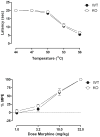

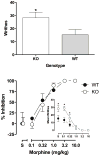

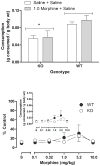
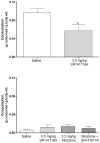

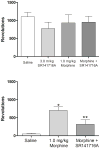
Similar articles
-
Effects of alterations in cannabinoid signaling, alone and in combination with morphine, on pain-elicited and pain-suppressed behavior in mice.J Pharmacol Exp Ther. 2012 Jul;342(1):177-87. doi: 10.1124/jpet.112.191478. Epub 2012 Apr 18. J Pharmacol Exp Ther. 2012. PMID: 22514333 Free PMC article.
-
Constitutive activity at the cannabinoid CB1 receptor is required for behavioral response to noxious chemical stimulation of TRPV1: antinociceptive actions of CB1 inverse agonists.J Neurosci. 2008 Nov 5;28(45):11593-602. doi: 10.1523/JNEUROSCI.3322-08.2008. J Neurosci. 2008. PMID: 18987195 Free PMC article.
-
Behavioral effects of morphine and cocaine in M1 muscarinic acetylcholine receptor-deficient mice.Psychopharmacology (Berl). 2007 May;191(4):985-93. doi: 10.1007/s00213-006-0671-1. Epub 2007 Jan 9. Psychopharmacology (Berl). 2007. PMID: 17211651
-
Targeting pain-suppressed behaviors in preclinical assays of pain and analgesia: effects of morphine on acetic acid-suppressed feeding in C57BL/6J mice.J Pain. 2006 Jun;7(6):408-16. doi: 10.1016/j.jpain.2006.01.447. J Pain. 2006. PMID: 16750797
-
The mu-opioid receptor agonist morphine, but not agonists at delta- or kappa-opioid receptors, induces peripheral antinociception mediated by cannabinoid receptors.Br J Pharmacol. 2008 Jul;154(5):1143-9. doi: 10.1038/bjp.2008.175. Epub 2008 May 12. Br J Pharmacol. 2008. PMID: 18469844 Free PMC article.
Cited by
-
Positive allosteric modulation of the mu-opioid receptor produces analgesia with reduced side effects.Proc Natl Acad Sci U S A. 2021 Apr 20;118(16):e2000017118. doi: 10.1073/pnas.2000017118. Proc Natl Acad Sci U S A. 2021. PMID: 33846240 Free PMC article.
-
Inflammation and nerve injury minimally affect mouse voluntary behaviors proposed as indicators of pain.Neurobiol Pain. 2017 Aug-Dec;2:1-12. doi: 10.1016/j.ynpai.2017.09.001. Epub 2017 Sep 8. Neurobiol Pain. 2017. PMID: 29075674 Free PMC article.
-
Home cage wheel running is an objective and clinically relevant method to assess inflammatory pain in male and female rats.J Neurosci Methods. 2016 Apr 1;263:115-22. doi: 10.1016/j.jneumeth.2016.02.013. Epub 2016 Feb 15. J Neurosci Methods. 2016. PMID: 26891874 Free PMC article.
-
High Times for Painful Blues: The Endocannabinoid System in Pain-Depression Comorbidity.Int J Neuropsychopharmacol. 2015 Sep 5;19(3):pyv095. doi: 10.1093/ijnp/pyv095. Int J Neuropsychopharmacol. 2015. PMID: 26342110 Free PMC article. Review.
-
Effects of (2R,6R)-hydroxynorketamine in assays of acute pain-stimulated and pain-depressed behaviors in mice.PLoS One. 2024 Apr 19;19(4):e0301848. doi: 10.1371/journal.pone.0301848. eCollection 2024. PLoS One. 2024. PMID: 38640139 Free PMC article.
References
-
- Ates M, Hamza M, Seidel K, Kotalla CE, Ledent C, Guhring H. Intrathecally applied flurbiprofren produces an endocannabinoid-dependent antinociception in the rat formalin test. Eur J Neurosci. 2003;17:597–604. - PubMed
-
- Calignano A, La Rana G, Giuffrida A, Piomelli D. Control of pain by endogenous cannabinoids. Nature. 1998;394:277–281. - PubMed
-
- Cossu G, Ledent C, Fattore L, Imperato A, Bohme GA, Parmentier M, Fratta W. Cannabinoid CB1 receptor knockout mice fail to self-administer morphine but not other drugs of abuse. Behav Brain Res. 2001;118:61–65. - PubMed
Publication types
MeSH terms
Substances
Grants and funding
LinkOut - more resources
Full Text Sources
Medical
Research Materials

